Sri Lankans are warm-hearted but at the same time emotional and quick to react. An argument between husband and wife, a parent or a teacher pulling up a child or a broken love affair and in a moment, the "reprimanded", "hurt" or even "angry" person would gulp something down.
In most cases, what is swallowed is a "corrosive" substance such as acetic, nitric, sulphuric or hydrochloric acid or caustic soda, detergents and even Harpic easily found in homes, MediScene understands.
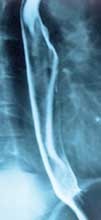 |
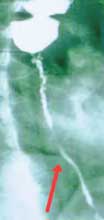 |
| X-ray showing a normal oesophagus and with benign stricture (right) |
Unfortunately, in some instances those who swallow these corrosive substances die but in others, after the acute phase is over the victims are left with serious burns of the mouth, the pharynx (the soft area at the top of the throat), the oesophagus (gullet), the stomach and even the larynx (vocal cords), it is learnt.
The trouble starts after the acute treatment is over, stresses Consultant Surgeon Dr. Gamini Goonetilleke of the Sri Jayewardenepura General Hospital, adding that such victims are left with narrowing of the food passage which may be the gullet, part of the stomach or the whole stomach.
While explaining that sometimes even accidental ingestion of a corrosive substance could occur because all these acids are colourless, come in bottles and look like water, he says they are easily available in many homes. "Acetic acid is used in the rubber industry, nitric acid in the jewellery industry, sulphuric acid in car batteries and hydrochloric acid in Harpic."
Accidentally or wilfully, once taken, the damage is done, depending on the quantity swallowed and its concentration, whether the person has eaten just before or taken it on an empty stomach. In a survey carried out by Dr. Goonetilleke at Sri Jayewardenepura General Hospital between 1994 and 2007 he has found that 76% of those treated with ingestion of a corrosive substance were young, in the age group 10-40 years, while more than half were females.
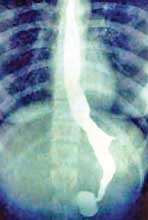 |
| X-ray of a contracted stomach |
As those who have ingested a corrosive substance may be in shock, severe pain with inflammation of the digestive system and if the substance has gone into the lungs struggling for breath and coming in for pneumonia, as soon as they are brought into hospital, they are rushed through from emergency to a medical ward, says Dr. Goonetilleke. In the worst-case scenario there could also be gullet perforation which would result in severe infection in the chest, leading to septicaemia.
Once the acute stage passes it is vital to see a surgeon at a hospital with good facilities, he urges, because "benign stricture" needs to be remedied urgently.
Why?
The answer is simple. "If the gullet is narrow, you get dysphagia -- that is you find it difficult to swallow," says Dr. Goonetilleke, explaining that the person will get dehydrated and then subsequently malnourished, losing weight and becoming skin and bone somewhat like a patient suffering from cancer.
The symptoms would depend on the area affected and whether it is one or multiple areas of the digestive system.
Endoscopy, barium swallow and barium meal, MediScene learns, are used to diagnose where the stricture is and whether one or many.
If the corrosive substance has destroyed the gullet, the food would get stuck there and the patient would regurgitate or bring it out immediately, he says, adding that if it is the stomach itself, there will be no capacity to retain the food. Speech would be affected if the larynx is destroyed while leaving the patient with stridor or noisy breathing.
Treatment
Sometimes as a temporary measure in the case of narrowing of a small area of the gullet, surgeons can stretch or dilate that segment, using a flexible endoscope with a balloon dilator, says Dr. Goonetilleke.
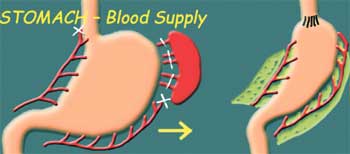 |
| Diagrammatic view-mobilised stomach with blood supply |
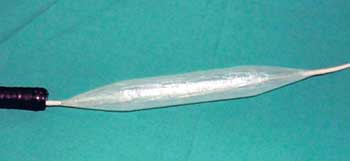 |
| Flexible endoscope with balloon dilator |
However, permanent correction is "replacement" surgery, he stresses, explaining that even if 1 cm or 10 cms of the gullet which is usually about 25 cms is destroyed, the whole oesophagus has to be replaced.
The graft material, of course, comes, along with the blood vessels, firstly from the stomach, secondly from the large bowel or colon and only as a last resort from the small intestine.
"The destroyed area is surgically removed and the selected segment with the blood supply intact is transferred right up to the neck. The blood supply has to remain, otherwise the segment of bowel used to replace the damaged gullet will undergo necrosis (death of tissue), explains Dr. Goonetilleke, adding that this intricate operation takes about six hours.
This is to restore the act of swallowing which in turn would allow the person to take food as usual, he adds.
Nutrition build up vital
It is of vital importance for a patient to be strengthened nutritionally before the permanent correction of a benign stricture, through complex surgery, is undertaken.
How can a person who is unable to eat, be provided nourishment?
Surgeons can place a feeding tube in the stomach or the proximal part of the small intestine, so that nutritious fluids can then be directly introduced to the digestive tract, says Dr. Goonetilleke.
Stressing on the need to prevent benign strictures, he advises parents to keep all corrosive substances under lock and key at home. "Don't make them easily accessible," he says. |





